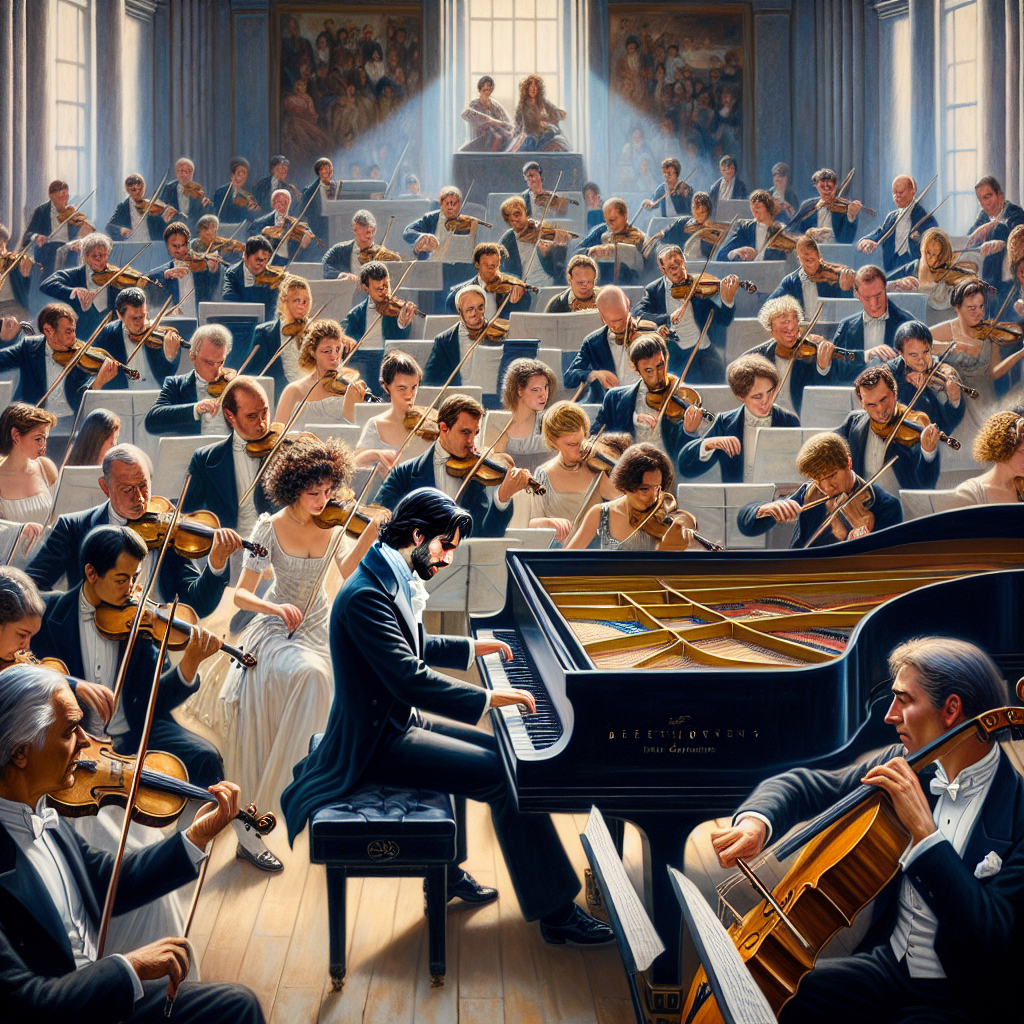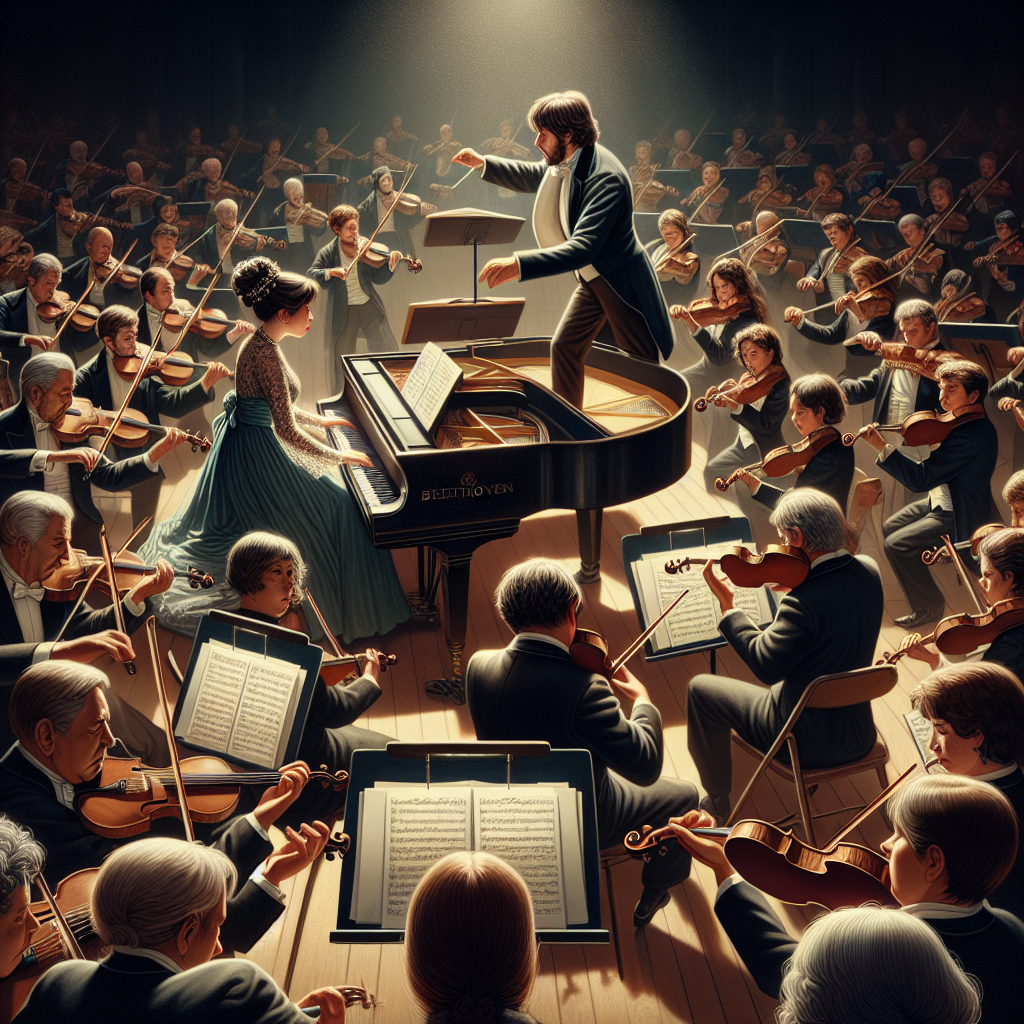
The Orchestration of Beethoven’s Piano Concertos
Renowned for his ingenuity and profoundly expressive compositions, Ludwig van Beethoven is heralded as one of the preeminent figures in the history of Western classical music. Among his extensive catalog, Beethoven’s piano concertos stand out as remarkable exemplars of his ability to combine technical brilliance with profound musicality. Spanning his early, middle, and late periods, these works reflect his evolving style and the revolutionary impact he had on the concerto form. This article delves into the intricacies of Beethoven’s piano concertos, examining their orchestration, structural innovations, and the compositional techniques that characterize each piece.
Introduced to music at a young age, Beethoven displayed prodigious talent, leading to advanced studies with prominent musicians like Christian Gottlob Neefe and, eventually, Joseph Haydn. His early mastery of the piano laid the foundation for his concertos, in which he intricately wove the piano’s capabilities with the breadth and power of an orchestra. Through these works, Beethoven not only showcased his pianistic prowess but also pushed the boundaries of what a concerto could achieve, both in terms of technical complexity and emotional depth.
The First Piano Concerto in C Major, Op. 15
Upon its initial unveiling, Beethoven’s Piano Concerto No. 1 in C Major was a testament to the burgeoning genius of its creator. Composed between 1796 and 1797, this concerto is somewhat misleadingly numbered, as it was actually the third to be composed, preceding the Concerto in B-flat Major (WoO 4) and the Piano Concerto No. 2 in B-flat Major, Op. 19. This opus, however, marks a pivotal moment in Beethoven’s early career, exemplifying his nascent departure from the stylistic conventions of his predecessors.
The introduction of the concerto is marked by a grandeur that immediately captures the listener’s attention. Beethoven employs a full orchestra, where each section plays a pivotal role in setting the stage for the soloist. The thematic material is robust and rhythmic, characteristics that would become hallmarks of Beethoven’s style. As the piano enters, it dialogues with the orchestra, often intertwining the solo and ensemble parts in a manner that was revolutionary for the time.
The second movement, Largo, exemplifies Beethoven’s ability to craft hauntingly beautiful melodies. The orchestration is more subdued, allowing the piano to shine with an almost vocal quality. The interplay between the soloist and the orchestra in this movement is tender and introspective, offering a glimpse into Beethoven’s growing emotional complexity.
The final movement, Rondo: Allegro scherzando, is a spirited and boisterous conclusion. It serves as a precursor to Beethoven’s later works, with its playful themes and intricate interplay between the orchestra and the piano. In summary, the first piano concerto offers a fascinating insight into Beethoven’s early compositional style, blending youthful exuberance with burgeoning technical mastery.
The Third Piano Concerto in C Minor, Op. 37
Widely regarded as a turning point in Beethoven’s concerto repertoire, the Piano Concerto No. 3 in C Minor demonstrates a significant leap in his compositional depth and complexity. This concerto, completed in 1800 and premiered by Beethoven himself in 1803, introduces a darker emotional landscape, reflective of his personal struggles, including his encroaching deafness.
The orchestration in this concerto is markedly more sophisticated than in his earlier works. From the very outset, the ominous opening theme set in C minor signals Beethoven’s intent to probe deeper emotional and musical territories. The piano’s entrance is commanding, with virtuosic passages that both challenge the performer and elevate the dramatic tension of the piece.
In the central Largo movement, Beethoven achieves a remarkable contrast to the stormy first movement. The orchestral color here is rich and warm, providing a lush backdrop to the piano’s serene and lyrically expansive lines. The sense of intimacy and expressiveness achieved in this movement is a testament to Beethoven’s maturation as a composer.
The third movement, Rondo: Allegro, returns to the tumultuous energy of the first. With its syncopated rhythms and dynamic interplay between the piano and orchestra, it exemplifies Beethoven’s exploration of contrast and tension. The conclusion reasserts the C minor tonality, providing a cohesive and powerful end to the concerto.

The Fourth Piano Concerto in G Major, Op. 58
Arguably one of Beethoven’s most lyrical and innovative piano concertos, the Fourth Piano Concerto, composed in 1805-1806, stands out for its remarkable structural and emotional qualities. This concerto breaks from tradition from the opening bars, where instead of the orchestra, the piano introduces the main theme – a gesture that was unprecedented at the time.
The orchestration in the Fourth Concerto is particularly noteworthy for its vivid color and subtlety. The interplay between the piano and the orchestra is delicate and nuanced, with the soloist often engaging in conversation with individual sections of the ensemble rather than competing against them. The first movement, Allegro moderato, showcases a wealth of melodic material and a fluid, almost improvisational dialogue between the piano and the orchestra.
The second movement, Andante con moto, is highly dramatic and has been the subject of much scholarly interpretation. The stark, almost recitative-like exchanges between the piano and the orchestra are thought to represent Orpheus taming the Furies, reflecting Beethoven’s fascination with mythological and philosophical themes.
The final movement, Rondo: Vivace, is buoyant and jubilant, bringing the concerto to an exhilarating conclusion. The rhythmic vitality and spirited themes exemplify Beethoven’s ability to blend complexity with accessibility. In its entirety, the Fourth Piano Concerto stands as a masterful synthesis of structural innovation, emotional depth, and lyrical beauty.
The Fifth Piano Concerto in E-flat Major, Op. 73 “Emperor”
Beethoven’s Fifth Piano Concerto, commonly known as the “Emperor,” is perhaps his most celebrated and grandiose contribution to the genre. Composed between 1809 and 1811, during a period of great personal and political turmoil, the concerto embodies a sense of heroism and majesty that has captivated audiences for centuries.
The bold orchestration of the “Emperor” Concerto is immediately apparent from the grandiose opening, where the piano joins the orchestra in a series of sweeping arpeggios and impassioned cadenzas. The first movement, Allegro, is characterized by its grand scale and the dramatic interplay between the soloist and the orchestra, with thematic material that exudes both power and nobility.
The Adagio un poco mosso that follows is a sublime contrast to the first movement’s grandeur. Here, Beethoven crafts an atmosphere of profound tranquility and introspection, with the piano weaving a serene and lyrical melody against the orchestra’s tender accompaniment. This movement exemplifies Beethoven’s unparalleled ability to convey deep emotion through music.
The triumphal final movement, Rondo: Allegro, bursts forth with a joyous energy and rhythmic drive. The piano and the orchestra are in constant, exhilarating interplay, leading to a resplendent conclusion. The “Emperor” Concerto remains a quintessential example of Beethoven’s late style, combining technical mastery, bold innovation, and emotional profundity.
The Evolution of Beethoven’s Orchestration Techniques
Throughout his five piano concertos, Beethoven’s orchestration techniques evolved considerably, reflecting his growth as a composer and his increasing confidence in handling larger orchestral forces. In his early concertos, Beethoven largely adhered to the Classical models established by Mozart and Haydn, but with each subsequent work, he expanded his orchestral palette and pushed the boundaries of the genre.
One notable aspect of Beethoven’s orchestration is his innovative use of wind instruments. In the Third Piano Concerto, for example, Beethoven employs the winds not merely for color but as active participants in the musical dialogue, often giving them significant thematic material. This trend continues and is further refined in the Fourth and Fifth Concertos, where the winds play a crucial role in the texture and character of the music.
Another significant development is Beethoven’s use of the timpani. Traditionally used primarily for emphasis and dramatic effect, in Beethoven’s hands, the timpani becomes a more integral part of the orchestra, contributing to the rhythmic drive and overall impact of the concertos, particularly evident in the “Emperor” Concerto.
Beethoven’s orchestration techniques also reveal his increasing interest in creating contrasts of texture and dynamics. He frequently juxtaposes sections of delicate, chamber-like intimacy with passages of full, powerful orchestral sound. This dynamic range is a key element in the emotional impact of his concertos, creating moments of tension, release, and profound beauty.
Conclusion
Ludwig van Beethoven’s piano concertos are monumental works that have left an indelible mark on the history of Western music. They reflect his journey as a composer, his personal struggles, and his revolutionary approach to the concerto form. Through innovative orchestration, structural creativity, and profound emotional depth, Beethoven transformed the piano concerto into a platform for both technical brilliance and expressive power.
From the youthful exuberance of the First Piano Concerto to the heroic grandeur of the “Emperor” Concerto, each work offers a unique glimpse into Beethoven’s creative genius. His ability to seamlessly integrate the piano with the orchestra, creating a balanced yet dynamic dialogue between the soloist and the ensemble, set new standards for the genre and influenced generations of composers.
In studying Beethoven’s piano concertos, we not only gain insight into his compositional techniques but also witness the evolution of the concerto itself. These works stand as a testament to Beethoven’s enduring legacy, his relentless pursuit of artistic excellence, and his unwavering belief in the power of music to convey the deepest human emotions.